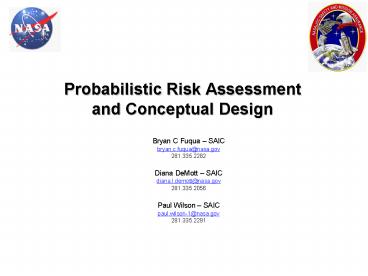Probabilistic Risk Assessment and Conceptual Design - PowerPoint PPT Presentation
Title:
Probabilistic Risk Assessment and Conceptual Design
Description:
Probabilistic Risk Assessment and Conceptual Design Bryan C Fuqua SAIC bryan.c.fuqua_at_nasa.gov 281.335.2282 Diana DeMott SAIC diana.l.demott_at_nasa.gov – PowerPoint PPT presentation
Number of Views:105
Avg rating:3.0/5.0
Title: Probabilistic Risk Assessment and Conceptual Design
1
Probabilistic Risk Assessment and Conceptual
Design
- Bryan C Fuqua SAIC
- bryan.c.fuqua_at_nasa.gov
- 281.335.2282
- Diana DeMott SAIC
- diana.l.demott_at_nasa.gov
- 281.335.2056
- Paul Wilson SAIC
- paul.wilson-1_at_nasa.gov
- 281.335.2291
2
What is PRA?
- Determining risk generally amounts to answering
the following three questions - What kinds of events or scenarios can occur
(i.e., what can go wrong)? - What are the likelihoods and associated
uncertainties of the events or scenarios? - What consequences could result from these events
or scenarios (e.g., Loss of Crew and Loss of
Mission)? - Probabilistic Risk Assessment (PRA) is a
comprehensive, structured, and logical analysis
method aimed at identifying and assessing risks
in complex technological systems for the purpose
of cost-effectively improving their safety and
performance. (PRA Procedures Guide for NASA
Managers and Practitioners) - They are often characterized by (but not limited
to) event tree models, fault tree models, and
physics based simulation models
3
Why Use PRA for Planning or Early in Concept
Phase?
- PRA can be applied in the conceptual design phase
and not just the operational phase - PRA can be utilized as a
- key input to the Risk Informed
- Decision Making process
- Identifies potential risks early to
- Determine what (equipment, process, mission,
etc.) drives the risk - Mitigate or eliminate risks earlier in design to
lower costs - Allows trade studies to compare design
alternatives based on risk
4
Use of PRA in Trade Studies
- Provide additional information for Risk Informed
Decisions made by management - Compare concept/design alternatives based on
risks - Determine magnitude of reduced risk due to
proposed changes in - Design
- Process
- Equipment / components
5
Using PRA Methodology
- Develop high level PRA models of Design Reference
Missions (DRMs) or early design prototypes - Models may include Event Trees, Fault Trees, or
other probabilistic-based applications - Models should be based on conceptual designs and
generic key system and equipment level
information - Using what is known today, we can quantify the
model(s) to predict magnitudes of risk, or
compare risks, for different designs - Following this methodology will provide
program/project management with a better
understanding of the risks
6
Key PRA Parameters to Develop
- Establish the scope of the model
- Understand and incorporate success criteria
- Use a high level approach to provide magnitude of
(not specific) risk - Master Equipment List (MEL)
- Find data (e.g., historical data, surrogate data,
etc.) - Use placeholder data for known future
considerations
7
PRA Results (Risk Drivers)
- Identify and characterize the key risks and
challenges associated with potential high risk
programs in aerospace or other industries - Loss of life
- Loss of equipment or facility
- Large financial loss
8
Conclusion
- PRA methodology is a tool that has the potential
to improve both conceptual planning and early
design efforts to help identify and ultimately
mitigate risks in a more efficient and cost
effective manner.































